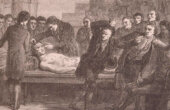New Chemistry and the Birth of Public Hygiene

“Capable of causing severe illnesses.” “Dangerous: incites blood in the cough spittle.” “Lethal.” “Suffocating.” Such late 18th-century descriptions of the acid vapors emanating from factories came from laborers, police commissioners, and the Parlement of Paris, the sovereign judiciary court. Similarly, in 1757 the British supreme court, the King’s Bench, called the gas emissions from a sulfuric acid factory in Twickenham, the London quarter where Joshua Ward established the first such factory in 1736, “noxious.” Like many other workshops that created nuisances, acid production was prohibited within the city limits.
Whereas fear and reticence shaped the early modern construction of laws surrounding nuisances, a new perspective emerged during the final third of the 18th century. The decisive turning point in Europe emerged from the chemical studies of Louis-Bernard Guyton de Morveau. When Dijon’s local authorities implored him in 1773 to disinfect one of the vaults in the city’s cathedrals, Guyton tested out hydrochloric acid vapors. He reused this method a few months later in a prison.

These experiments were regarded as major victories against the hazards of infection and had an immense impact. For Alain Corbin, this disinfection constituted a decisive step in the cultural transformation of olfactory smells: Up to this point, the battle against miasma and pestilence was fought with vinegar-based and other aromatic compositions used against putrefaction; or fire to cleanse.
By the following year, the physician Félix Vicq-d’Azyr prescribed these kinds of fumigations to treat epizootic diseases in the south of France, while Étienne Mignot de Montigny and Philibert Trudaine de Montigny — both members of the French Academy — recommended similar practices to arrest the spread of contagious livestock diseases. In his two “Dissertations” on the waters of the Seine (1775 and 1787), Antoine Parmentier, scientific counsel to the lieutenant-general of police for Paris, asserted that acid and alkaline vapors contributed to clean air by neutralizing the miasmas dispersed in the atmosphere.
Recruited to write the “Chemistry” section of the “Encyclopédie Méthodique” (1786), Guyton praised acids, “the key of chemistry,” without bothering to pause and consider their more dangerous applications or inherent risks in the laboratory. In 1801, having risen to the French Academy and become a public figure in the Consulate, Guyton published his “Traité des moyens de désinfecter l’air” [Treatise on Means of Disinfecting the Air], in which he attempted to demonstrate the superiority of his disinfection methods. His colleague and fellow chemist, Jean-Antoine Chaptal, at that point Minister of the Interior, was quick to distribute the work throughout the prefectures. Subsequently referred to as “Guytonian fumigations,” Guyton’s acid vapor methods spread throughout Europe. In Spain, the state encouraged their adoption in the fight against yellow fever in Cadiz and Séville. In Great Britain, the Scottish physician James Smyth carried out nitric acid fumigations in 1780 in response to an epidemic. The Royal Navy repeated the exercise in 1796.
As disinfection became entrenched as a public health practice, chemists emerged as the unquestioned experts in evaluating sanitary hazards.
Controlling pollutions through disinfection, rather than preventing them outright, marked a critical feature of the chemical revolution that crested in the 1770s. Throughout Europe its pioneers, from Henry Cavendish and Joseph Priestley in Great Britain to Carl Wilhelm Scheele in Sweden, and especially Antoine-Laurent Lavoisier in France, introduced the foundations of modern chemistry with their work on combustion, air, water, and the conservation of mass. In 1789, Lavoisier wrote his seminal “Traité élémentaire de Chimie” [Elementary Treatise on Chemistry], two years after proposing the new classification of elements for the Enlightenment, alongside Antoine de Fourcroy, Berthollet, and Guyton. The classification formalized a new language for understanding chemistry and its components.
These new chemical discoveries — not least the new method of “seeing” chemical work — encouraged greater convergence and collaboration between chemistry, medicine, and pharmacology. As a result, Chaptal, Berthollet, and Fourcroy — physicians before converting to chemistry — became captivated by the new work’s potential industrial applications and developed a number of acid- and chlorine-based substances in the interest of marrying manufacturing activity and public health.

A kind of pre-public hygiene movement — integrating neo-Hippocratic medicine and the new chemistry to clean up urban spaces — accompanied this transformation in medical and scientific knowledge. Paris, “la ville des lumières,” fought to eliminate putrid miasmas that emanated from its environment, be it stagnant air or water, swamps, wetlands, riverbanks, narrow streets, and densely populated spaces: theatres, prisons, ships, workshops, and hospitals. In order to eliminate bad odors, a key indicator of pollution, new artificial ventilation systems and methods to dry out humid spaces were devised.
But chemical treatment became increasingly common. In Paris, the chemist Alexis Cadet de Vaux promoted quicklime to disinfect garbage dumps and horse slaughterhouses. He also experimented with sulfuric acid and hydrochloric acid as disinfectants in dumps and landfills. At the beginning of the nineteenth century, Parisian authorities encouraged the establishment of caustic soda plants next to organic matter waste sites so that the hydrochloric acid could annihilate miasmas.
Increasingly, chemists started working with chlorine alone as a purifying agent; however, these processes were immediately met with opposition. In one of the first chlorine bleaching attempts in the textile industry, the industrialist O’Reilly testified “the poor workers suffered cruel pain from the powerful vapors. I saw them rolling on the ground in agony; frequently even serious illnesses followed from these first exposures to muriatic acid (hydrochloric acid).” By the 1820s, the chemist Antoine Labarraque sought to diminish the product’s more corrosive qualities by adding lye. Labarraque managed to remove the butcher’s odors by immersing the unused animal entrails in sodium chloride tubs. The great disinfection campaign that followed was not exempted from controversies surrounding chlorine’s purported innocuous qualities. At the minimum, however, the debate supported the notion that chlorine and chlorine-related products be manufactured under the direction of eminent chemists, even if that work should take place in the heart of the same cities that had once evicted polluters to their outskirts.
Chemists and chemical experts came from a class of (almost exclusively) gentlemen of means, most of whom were also part of a moneyed elite. Their expertise and their economic interests were rarely far apart.
As disinfection became entrenched as a public health practice, chemists emerged as the unquestioned experts in evaluating sanitary hazards, whether the risks pertained to the copper pots used in distributing milk, lead counters used by wine bottlers, the varnishes that coated kitchen utensils, the effects of cemeteries on the still-living population, and especially emissions from manufacturing. In 1778, the French Royal Society of Medicine entrusted the chemist Pierre Macquer with the task of evaluating the ambient toxicity of an antimony factory, and in 1783 Fourcroy was asked to determine whether a Rouen sulfuric acid manufacturer’s activities threatened to degrade the environment and pose a health threat to nearby inhabitants.
Chemical expertise tended to favor industrial expansion, and chemistry bounded the debate in ways that opponents of the new techniques — lacking facility with this new language and practice — found themselves hard-pressed to make their objections heard. When a similar new factory was proposed in Paris in 1778, authorities could argue that “it is understood in medicine and chemistry that the evaporation of sulfur, rather than being detrimental to health, is in fact a boon. It purifies dirty air. It prevents epidemics. It even fortifies the lungs.”
Industrial operations throughout Europe found chemists indispensable. Chemists were inextricably involved in all manner of works to compose and transform matter in the factory, and in the combustion or disposal of wastes — or in creating new products and generating value from that waste.
In Prussia, they assisted in porcelain manufacture, furnace construction, and in developing new dyes and pigmentations. In St. Petersburg, investments were made in military and medical institutions where new chemical research sites were built specifically for chemists to expand chemical knowledge, working independently from traditional artisanal knowledge. In the Habsburg Empire, they acted as prime movers at the mining academy as experts in copper works.
Absent any formal or professional accreditation, the title “expert” was loosely attributed to any individual on whom judicial courts could call to testify under oath. Increasingly, experts were designated as anyone who could make a technical evaluation of industrial practices or on their relationship to health. Chemists and chemical experts came from a class of (almost exclusively) gentlemen of means — who else could afford to experiment with matter? — most of whom were also part of a moneyed elite. Their expertise and their economic interests were rarely far apart. Macquer and Berthollet were members of the French Bureau of Commerce. And while Guyton promoted his beloved acids in his 1801 “Treatise,” he was perfectly aware of their commercial value, independent of any sanitary concerns:
But if it is possible, without danger, to restrict the prohibitions, to shorten the duration of the sanitary trials, how can we refuse to deliver trade from these obstacles? A few hours of fumigations [of the goods], by sulfur combustion, by the emission of simple oxygenated or muriatic acid gas, according to the circumstances, will infallibly give a more secure guarantee than a month of exposure to the open air, regardless of the nature of the contagious virus. What is the cost they would incur in comparison with the benefits that would result?
Removing older regulations that had protected public health against epidemics (quarantines, isolation, destruction of infected goods), the new project of “pre-hygienism” encouraged the active pursuit of commerce and wealth in multiple countries.
François Jarrige is Senior Lecturer in Contemporary History at the University of Burgundy (Dijon) and coauthor (with Thomas Le Roux) of “The Contamination of the Earth.”
Thomas Le Roux is Researcher at the French National Center for Scientific Research (CNRS).



